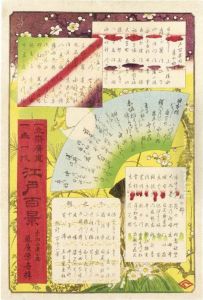Baisotei Gengyo Paintings
Baisotei Gengyo was a Japanese artist known for his work in the ukiyo-e genre of woodblock prints and paintings during the Edo period. Born in 1800, Gengyo's real name was Matsuno Chikanobu, and he was also known by the name Matsuno Gengyo. His adopted artist name 'Baisotei' translates to 'Plum-Grass Pavilion,' which reflects a common practice among Japanese artists of the time to take on poetic or nature-inspired names.
Gengyo's artistry lies within the rich tradition of ukiyo-e, which focused on subjects like kabuki actors, sumo wrestlers, bijin-ga (pictures of beautiful women), landscapes, and scenes from folk tales and history. While Gengyo was not as prominent as some of his contemporaries such as Hokusai or Hiroshige, he contributed to the ukiyo-e movement with his distinct style and technique.
Little is known about Gengyo’s personal life or training. However, it is believed that he may have been a student or follower of Utagawa Toyokuni I, as his style bears similarities to the Utagawa school. His works, though not extensively documented, are appreciated for their delicate lines and attention to detail.
Gengyo's career spanned a period of significant transition in Japan as the country slowly opened up to Western influences after centuries of self-imposed isolation. Despite this, Gengyo's works remained firmly rooted in the traditions of Japanese aesthetics. One of his notable contributions was a series of prints depicting the 'Fifty-three Stations of the Tokaido,' which was a popular subject among ukiyo-e artists and highlighted the famous road connecting Edo (modern-day Tokyo) to Kyoto.
Baisotei Gengyo passed away in 1862, leaving behind a modest but respected body of work. His prints continue to be studied by enthusiasts of Japanese art and ukiyo-e for their cultural and historical significance. Although not as widely recognized as some of his peers, Gengyo’s work provides a valuable window into the world of Edo-period Japan and its rich artistic heritage.
